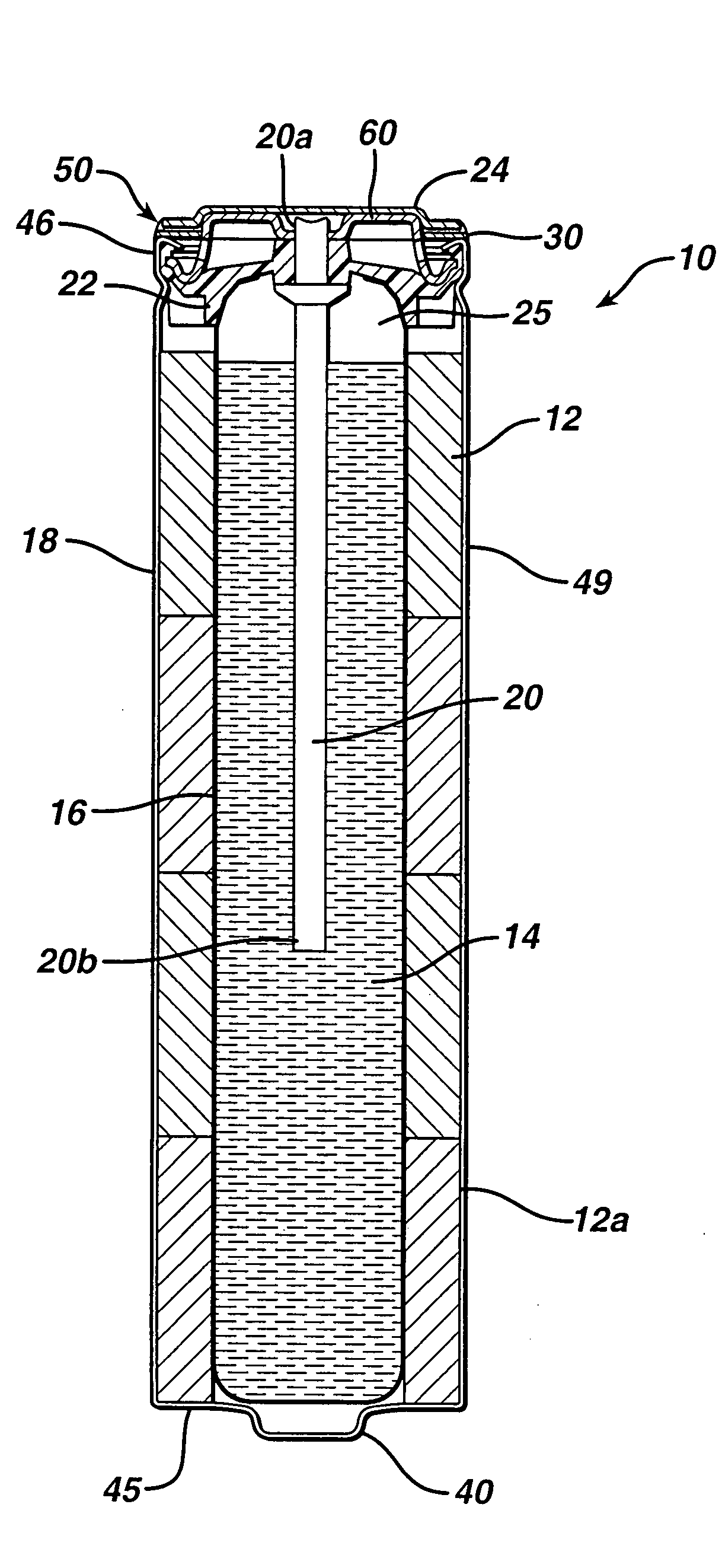Alkaline battery including nickel oxyhydroxide cathode and zinc anode
a zinc anode and alkaline battery technology, applied in the field of alkaline batteries, can solve the problems of decreasing the rate of electrochemical reaction during discharge, the approach has several practical limitations, and the cell cannot generate hydrogen gas, so as to improve the discharge performance and improve the capacity retention effect of discharge performan
- Summary
- Abstract
- Description
- Claims
- Application Information
AI Technical Summary
Benefits of technology
Problems solved by technology
Method used
Image
Examples
example 1
(Anode Formulation E, 32 wt % −325 Mesh Zinc Fines) (Cathode Formulation B, 8 wt % Natural Graphite, 0 wt % Oxidation Resistant Graphite)
[0148] Test cells of AA size were fabricated having an anode of formulation E and a cathode of formulation B. The amounts of NiOOH and natural graphite in the cathode, total zinc in the anode, and the cell balance were the same as for Comparative Example 2. However, 50% of the total zinc in the anode was in the form of zinc fines (i.e., −325 mesh).
[0149] Fresh test cells were discharged continuously at 1 Watt until cell voltage decreased to 0.9 Volt. Total energy output was 1.31 Watt-hrs corresponding to a service life of 1.31 hours. Other fresh test cells were discharged intermittently at 1 Watt until cell voltage decreased to 0.9 Volt. Total energy output was 2.34 Watt-hrs corresponding to a service life of 6.28 hours. The performance index for fresh test cells of Example 1 was 0.65. Other test cells were discharged intermittently at 1 Watt for...
example 2
(Anode Formulation E, 32 wt % −325 Mesh Zinc Fines) (Cathode Formulation C, 8 wt % Oxidation Resistant Graphite)
[0151] Test cells of AA size having an anode of formulation E and a cathode of formulation C were fabricated. The amounts of NiOOH and graphite in the cathode and total zinc in the anode were the same as used in the test cells of Example 1. An oxidation-resistant synthetic graphite was substituted for the natural graphite in the cathode and 50% of the total zinc in the anode was in the form of zinc fines.
[0152] Fresh test cells were discharged continuously at 1 Watt until cell voltage decreased to 0.9 Volt. Total energy output was 1.53 Watt-hrs. Other fresh test cells were discharged intermittently at 1 Watt until cell voltage decreased to 0.9 Volt. Total energy output was 2.24 Watt-hrs. The performance index for fresh test cells of Example 2 was 0.71. The same tests were repeated using test cells stored for 1 week at 60° C. before discharge at room temperature. Total en...
example 3
(Anode Formulation F, 44.8 wt % −325 Mesh Zinc Fines) (Cathode Formulation C, 8 wt % Oxidation Resistant Graphite)
[0153] Test cells of AA size having an anode of formulation F and a cathode of formulation C were fabricated. The amounts of NiOOH and graphite in the cathode and total zinc in the anode were the same as used in the test cells of Example 2. In addition to the oxidation-resistant graphite in the cathode, 70% of the total zinc in the anode was in the form of zinc fines (i.e., −325 mesh).
[0154] Fresh test cells were discharged continuously at 1 Watt until cell voltage decreased to 0.9 Volt. Total energy output was 1.76 Watt-hrs. Other fresh test cells were discharged intermittently at 1 Watt until cell voltage decreased to 0.9 Volt. Total energy output was 2.23 Watt-hrs. The performance index for fresh test cells of Example 3 was 0.76. The same tests were repeated using test cells stored for 1 week at 60° C. before discharge at room temperature. The total energy output wa...
PUM
 Login to View More
Login to View More Abstract
Description
Claims
Application Information
 Login to View More
Login to View More - R&D
- Intellectual Property
- Life Sciences
- Materials
- Tech Scout
- Unparalleled Data Quality
- Higher Quality Content
- 60% Fewer Hallucinations
Browse by: Latest US Patents, China's latest patents, Technical Efficacy Thesaurus, Application Domain, Technology Topic, Popular Technical Reports.
© 2025 PatSnap. All rights reserved.Legal|Privacy policy|Modern Slavery Act Transparency Statement|Sitemap|About US| Contact US: help@patsnap.com


